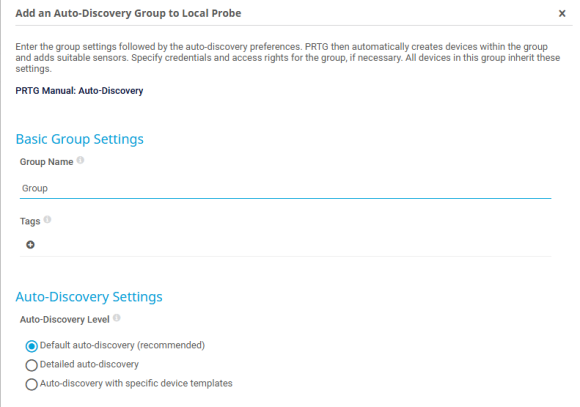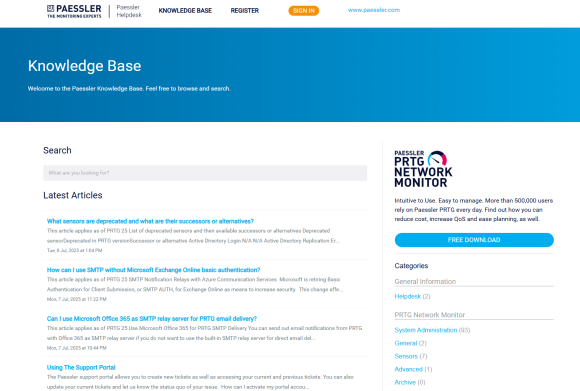Vue d'ensemble
Avant de commencer à superviser votre réseau à l'aide de PRTG Monitor, vous devez franchir certaines étapes importantes. Ce module de formation en ligne présente une Vue d'ensemble des principales fonctionnalités de PRTG et quelques concepts importants de PRTG, tels que les " capteurs " et les " statuts des capteurs ", ainsi qu'une explication de la licence PRTG. Il explique également comment préparer votre infrastructure IT à être supervisée et formule des recommandations concernant le matériel et le système d'exploitation de votre système PRTG.
Vue d'ensemble de PRTG (Vidéo)
Principales fonctionnalités de PRTG (Site web)
Qu'est-ce qu'un "capteur" dans PRTG ? (Base de connaissances)
Installation et configuration initiale avec smart setup
Tout ce que vous avez toujours voulu savoir sur l'administration de PRTG : dans ce module, vous apprendrez à installer PRTG et à activer le logiciel. Vous apprendrez également à mettre à jour le logiciel PRTG, à faire des sauvegardes de votre installation PRTG ou à migrer vers un nouveau serveur.
Mise à jour automatique (Manuel)
Mise à jour automatique (Vidéo)
Comment sauvegarder PRTG (base de connaissances)
Comment migrer PRTG vers un autre système (Site Web)
Gestion des droits d'accès (Manuel)
PRTG Administration Tool (Manuel)
PRTG Administration Tool (Vidéo)
Superviser à distance avec des sondes distantes
Qu'est-ce qu'un serveur central ? Qu'est-ce qu'une sonde distante ? Ce module explique les composants et les interfaces utilisateur de PRTG, et donne une Vue d'ensemble de la disposition de l'interface utilisateur. Il traite ensuite des sondes distantes et des scénarios dans lesquels elles sont utiles. Pour ceux qui ont besoin d'une haute disponibilité pour leur supervision, ce module inclut également des détails optionnels sur le clustering dans PRTG.
Architecture et interfaces utilisateur (Manuel)
Applications PRTG pour iOS ou Android (Site web)
Présentation générale (Manuel)
Structure du menu principal (Manuel)
Sondes distantes et sondes multiples (Manuel)
Supervision distribuée avec PRTG (Vidéo)
Comment installer une sonde distante (Site web)
Cluster dans PRTG - Voici comment ça marche (Vidéo)
Cluster de basculement (Manuel)
Qu'est-ce que la fonction de cluster dans PRTG ? (Base de connaissances)
Comment mettre en place un cluster PRTG (Vidéo)
Comment configurer un cluster de basculement dans PRTG (Site web)

Découverte automatique (manuelle)
Dans ce module, vous apprendrez à structurer votre arborescence des équipements, afin d'organiser PRTG exactement comme vous le souhaitez. Vous découvrirez la hiérarchie des objets de PRTG et l'héritage, ainsi que la manière d'organiser l'arborescence des équipements pour tirer parti de l'héritage. Ce module d'e-learning couvre les modifications manuelles de l'arborescence des équipements, la découverte automatique, les bibliothèques (vues alternatives de l'arborescence) et les modèles d'équipements.
Hiérarchie des objets (Manuel)
Héritage des paramètres (Manuel)
Comment modifier l'arborescence des équipements (Vidéo)
Gestion de l'arborescence des équipements (Manuel)
Découverte automatique (Manuel)
Configuration des appareils et des capteurs (Manuel)
Comment utiliser les bibliothèques dans PRTG (Site Web)
Les bibliothèques dans PRTG (Vidéo)
Création de capteurs SNMP
Maintenant que vous savez comment structurer votre arborescence des équipements, il est temps d'en apprendre plus sur les capteurs. Ce module aborde les protocoles les plus courants utilisés par les capteurs de PRTG et explique comment configurer les capteurs de base. Il aborde en détail les capteurs SNMP et les capteurs de bande passante, ce qui vous permettra d'apprendre à configurer les types de capteurs PRTG les plus importants.
Qu'est-ce qu'un capteur ? (Vidéo)
Liste des types de capteurs disponibles (Manuel)
Comment ajouter un capteur manuellement (Vidéo)
Quand un capteur change-t-il d'état ? (Vidéo)
Principes de base du SNMP (Vidéo)
Comparaison de la supervision de la bande passante (Manuel)
Méthodes de supervision de la bande passante (Vidéo)
Supervision de la bande passante avec SNMP et WMI (Vidéo)
Supervision de la bande passante par reniflage de flux et de paquets (Vidéo)
Capteurs de flux et renifleurs de paquets
Ce module aborde certains des capteurs PRTG les plus avancés, tels que les capteurs personnalisés, les capteurs récepteurs et les capteurs agrégés. À la fin de ce module, vous serez en mesure de configurer vos propres capteurs SNMP personnalisés, vos capteurs de scripts personnalisés et vos capteurs de flux. Ce module aborde également la manière de superviser des domaines spécifiques de votre infrastructure, tels que les environnements de virtualisation ou la VoIP.
Liste des des capteurs personnalisés (manuel)
Capteurs personnalisés SNMP et capteurs personnalisés de la bibliothèque SNMP (Vidéo)
Capteurs de réception :
Supervision de la bande passante avec reniflage de flux et de paquets (Vidéo)
Liste des capteurs de serveur Web (HTTP) (Manuel)
Capteurs récepteurs SNMP Trap et syslog (Vidéo)
Capteurs composites :
Comment puis-je utiliser le capteur Business Process ? (Base de connaissances)
Superviser des domaines spécifiques de votre infrastructure IT :
Superviser les bases de données (manuel)
Superviser les environnements virtuels (manuel)
Introduction aux notifications
Ce module vous montre comment configurer des seuils pour vos capteurs, afin que vous puissiez voir immédiatement s'il y a un problème dans votre réseau. Dans ce module, vous apprendrez comment et où configurer les limites des capteurs, comment configurer les notifications et comment déclencher ces notifications.
Quand un capteur change-t-il d'état ? (Vidéo)
Comment définir des limites de canaux (Vidéo)
Délivrance des notifications (Manuel)
Contacts de notification (Manuel)
Modèles de notification (Manuel)
Comment configurer les notifications via l'interface Web PRTG (Site Web)
Paramètres des canaux (Manuel)
Paramètres des déclencheurs de notifications (Manuel)
Cas d'utilisation des notifications (Vidéo)
Quels caractères génériques puis-je utiliser pour PRTG ? (Base de connaissances)
Création de cartes
Ce module traite des méthodes permettant de visualiser les résultats de votre supervision : tableaux de bord en temps réel, cartes géographiques et rapports historiques. À la fin de ce module, vous serez en mesure de créer vos propres tableaux de bord graphiques, d'afficher vos appareils sur une carte géographique et de générer des rapports personnalisés.
Cartes et Localisation :
Comment créer des tableaux de bord dans PRTG avec la fonction Cartes (Site Web)
Les rapports dans PRTG :
Paramètres des rapports (Manuel)
Rapports sur les données historiques (Manuel)
Comment créer des rapports dans PRTG (alimentation sans interruption)

Base de connaissances de Paessler
Que faire quand on ne sait pas quoi faire ? Ce module d'e-learning présente les ressources les plus importantes pour en savoir plus sur PRTG : le manuel, la base de connaissances et les tutoriels vidéo. Il aborde ensuite les outils gratuits proposés par Paessler pour vous aider à déboguer les problèmes, ainsi que des liens vers les problèmes les plus courants rencontrés avec PRTG, avec des conseils pour les résoudre.
Ressources générales :
Base de connaissances de Paessler
Outils réseau gratuits de Paessler
Problèmes courants :
Mes capteurs SNMP ne fonctionnent pas (Base de connaissances)
Mes capteurs WMI ne fonctionnent pas (Base de connaissances)